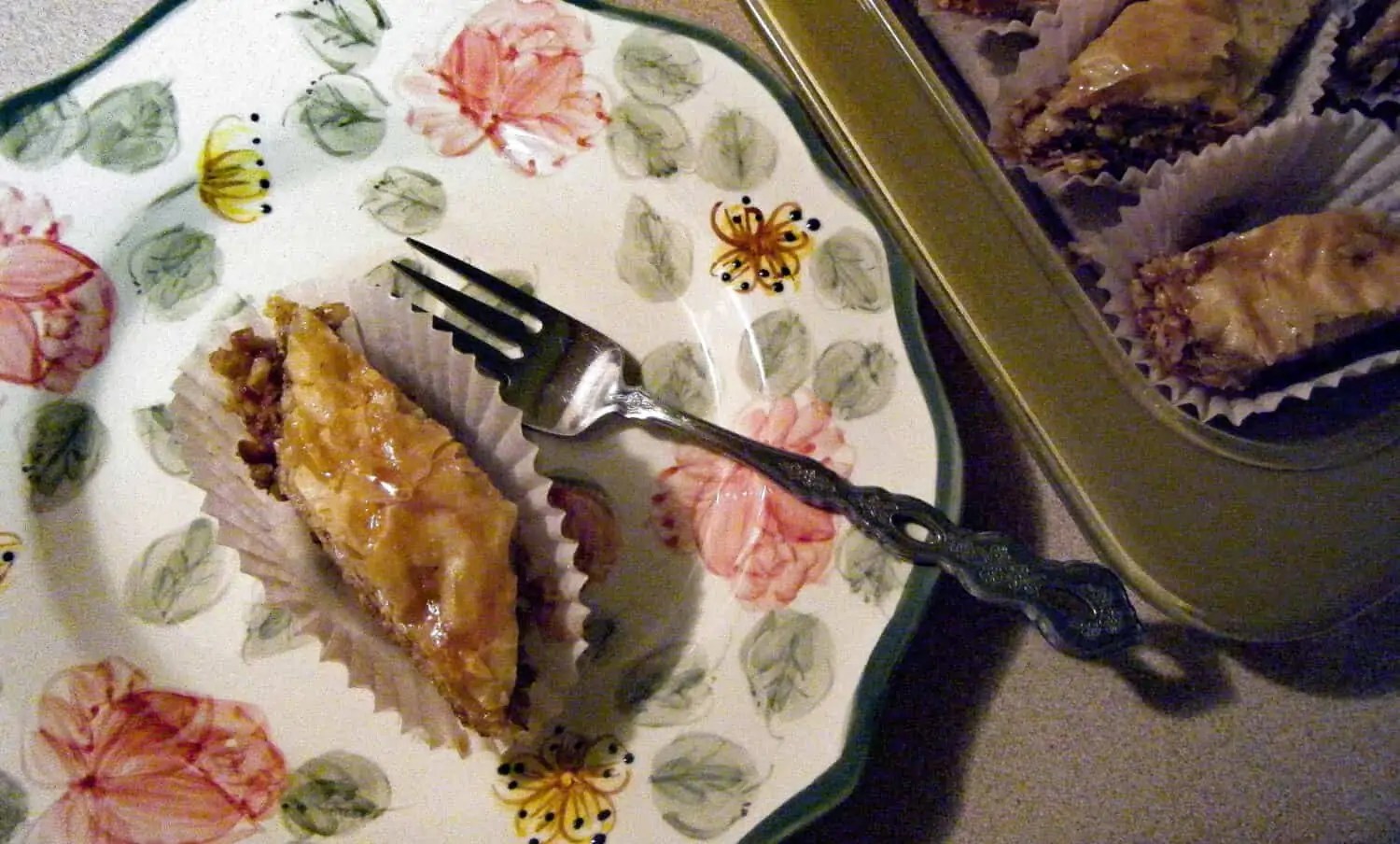
Jump to Recipe Print Recipe
Well, OK, not really fat. But Big. And Greek. And Baklava!
This stuff is amazing. Really.
It’s a little time consuming if you don’t have a food processor. Which I didn’t when I first started making it.
But oh, so worth it.
And today I just happened to be home all alone so Idecided to go play in the kitchen.
I love being home all alone.
I can crank up my music as loud as I want and don’t have to see anyone stomp into the kitchen, roll their eyes at me and say, “Mo-ther! Turn your music down! You’re not the only one who lives here ya know!”
Not that that has anything to do with Greece. Or Baklava. It just makes me giggle. 🙂
But back to the Baklava.
The history of this amazingly crispy, gooey, and sweet dessert is a little unclear.
Both Greece and Turkey claim to be the traditional place of origin and there are centuries old recipes from both cultures, but the ancient Romans also had similar recipes.
Different regions used different types of nuts depending on what was available locally. Pistachios, walnuts, and hazelnuts figured heavily in the most traditional recipes.
But the one thing they all have in common is that they all use incredibly thin layers of dough in between layers of filling.
I looked at many different recipes and combined several to make this. It uses several different spices, but no worries if you don’t have them all.
Some of the recipes I looked at only called for cinnamon. So just use what you have on hand.
So, without further ado, I give you, Homemade Baklava!!
Pin for later

Baklava Recipe
- 1 pound ofnuts (I used walnuts, hazelnuts, and pecans because that’s what I happened to have in my freezer. You can use any kind as long as they are raw and unsalted.)
- 1 tsp ground cinnamon
- 1/2 tsp each of the following spices: (I like to get my spices from Mountain Rose Herbs)
- ground nutmeg
- ground cloves
- mace
- ground cardamom
- allspice
- 1 16ozpackage phyllo dough at room temperature
- 1 cup melted butter
Start by preheating your oven to 350° F.
Then, generously butter a 9 x 13 inch baking dish. You can use glass or stoneware or even metal. Doesn’t matter.
Now for the most labor intensive part. Chop the nuts very fine. You can do this by hand or in a food processor.
I usually do it by hand because I don’t like the noise that my food processor makes. 🙂
If you are using a food processor, keep an eye on it because you don’t want to make nut butter.
Or, maybe you do.
Just not right now.

Chopped nuts are so fine! Or is that finely chopped nuts?
After all the nuts are chopped, put them into a small bowl and mix the ground spices into them.

Don’t the spices look pretty?
Ok, now comes the tricky bit.
Unroll the phyllo dough and place it on a cookie sheet (or your counter top if it’s clean enough).
Mine measured 9 x 14 so I had to cut an inch off of one end so it would fit my baking dish.
Now, cover the phyllowith plastic wrap and then with a damp cloth.
Some people say to just cover it with the damp cloth, but that made my phyllokinda soggy and it stuck together.
So now I cover it with the plastic wrap first.
Layering the Baklava
To start the layering process, place 4 to 6 sheets of phyllo in the bottom of your baking dish. Brush each one generously with melted butter.

Phyllo brushed with butter
Sprinkle 5 to 6 tablespoons of the nut mixture evenly over the phyllo buttered.
You can put more than that if you want, just keep in mind that too much in any one layer will make the Baklava not stick together as well.

Now, add2 more sheets of phyllo dough and brush with butter.
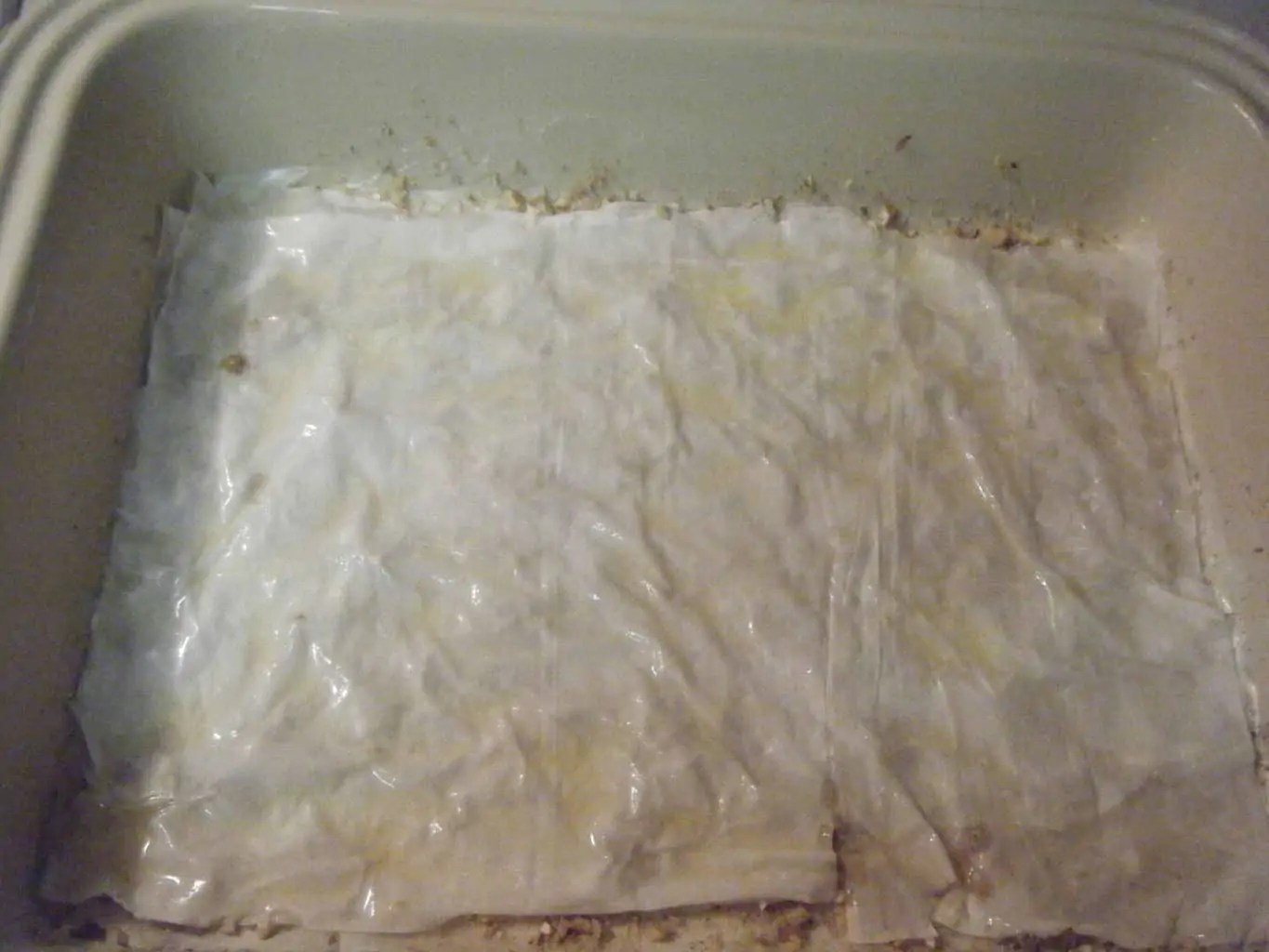
Lather. Rinse. Repeat.
Continue to layer the nuts and phyllosheets, brushing the sheets with butter as you go, until you have used all of the nut mixture.
For the top layer of phyllo, use 6 to 8 sheets, buttering each one.

Last layer of phyllo
Now, using a very sharp knife, cut the Baklava all the way through, into 4 or more long rows.
Then cut diagonally to make diamond shapes.

Cut and ready for the oven!
Confession time. I didn’t cut mine in small enough pieces before I baked it. I should have cut it in 6 rows instead.
So, after it cooled, I cut the pieces smaller.
After you’ve got your diamonds cut, pop it in the oven and bake the Baklava for 40 to 50 minutes or until it’s a golden brown.

All that golden loveliness!
While the oven is doing its thing, it’s time to make the syrup to pour over the all that golden loveliness.
Syrup for Baklava
- 1 cup packed sucanat or brown sugar (you can get sucanat here
)
- 1 cup water
- 1/2 cup honey
- 1 tsp homemade vanilla extract
- 1 tsp lemon juice
- peel from 1 orange, washed, cut in strips, and pith removed
- 2 cinnamon sticks
- 6 whole cloves
To make the syrup, combine the sucanat and the water in a small saucepan and bring it to a boil.

Sucanat dissolving in the water
After that comes to a boil, add the honey, cinnamon sticks, cloves and the orange peel.
Again, if you don’t have add of these things, it’s OK. Just use what you have.
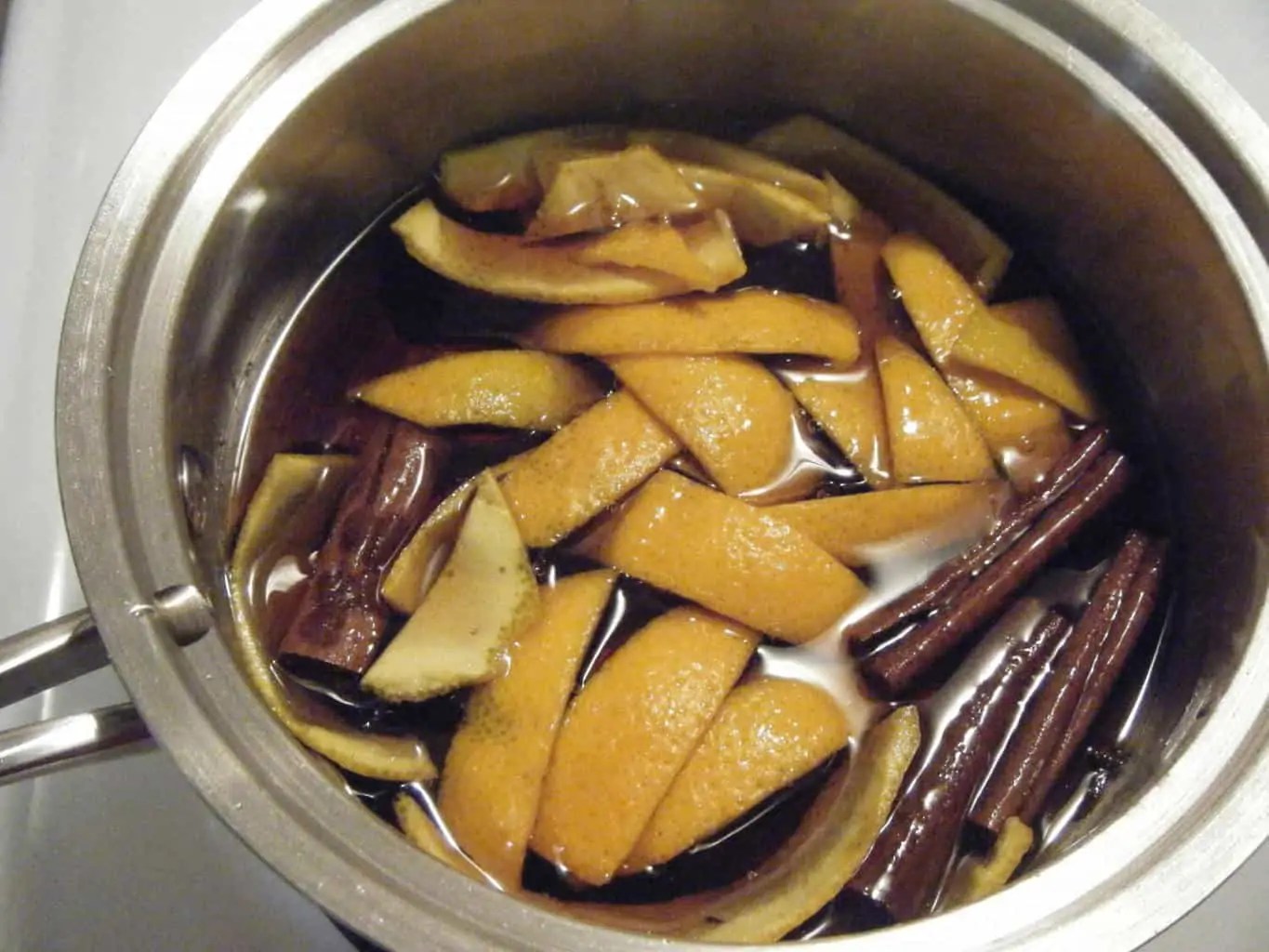
All the good stuff added to the pan
Let that come back to a full boil, then reduce the heat and simmer for 20 minutes.
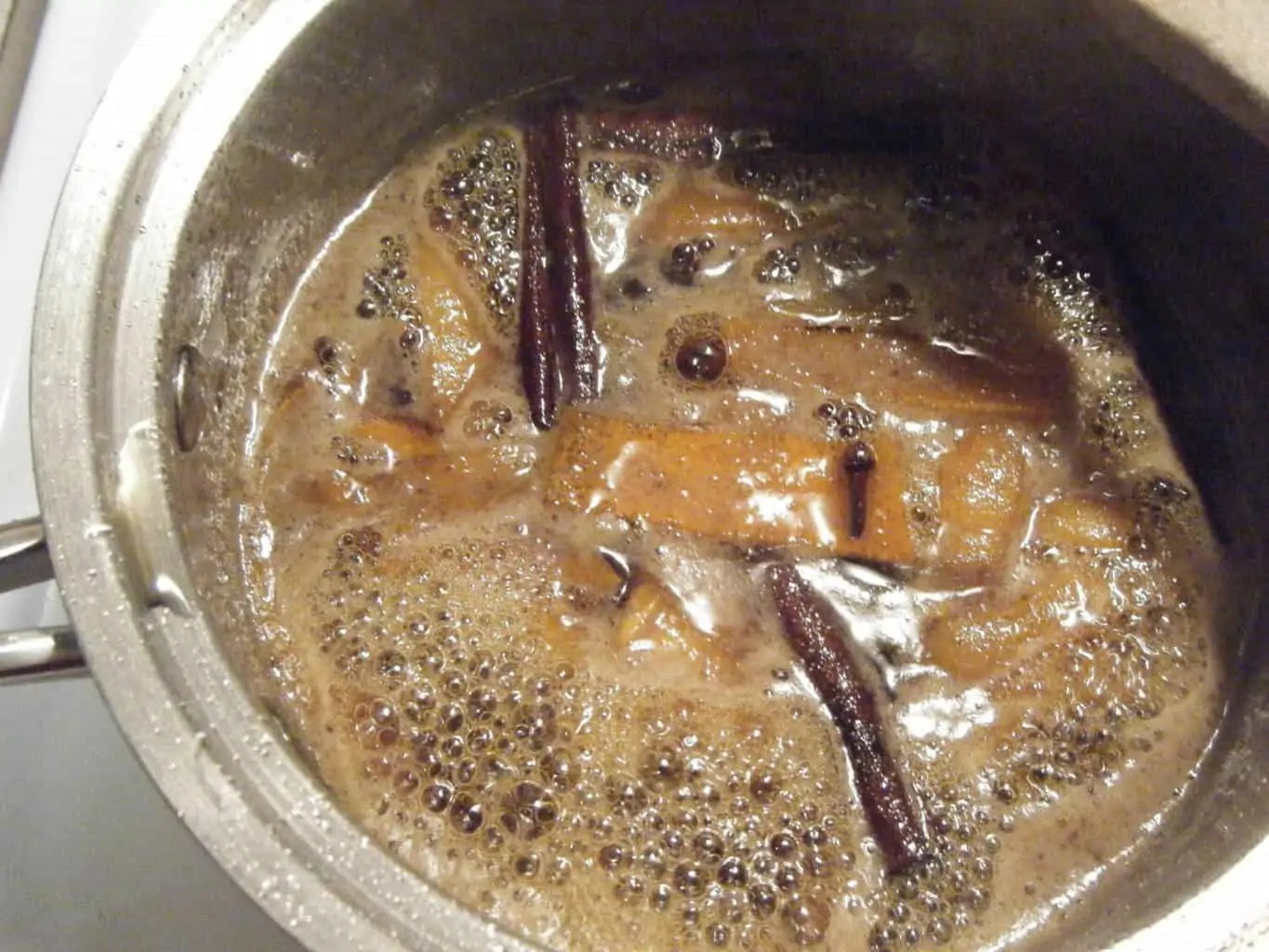
Simmering merrily
After the simmering, the syrupwill be reduced and nicely thick.
Remove and discard the cloves and cinnamon sticks.
The orange peel is now “candied” orange peel and can be used in other recipes. Or, you can put it in the dehydrator and then eat it like candy.
Add the lemon juice and the vanilla and mix well.
Remove the syrup from the heat and allow to cool slightly.
After removing the Baklava from the oven, immediatelyspoon the syrup over the top.
As a bonus it makes a really cool noise while you do it. 🙂

With the syrup all soaked in.
Let the Baklava cool completely before serving.
I like to put it in cupcake papers to serve it.
That makes it easier to handle and looks pretty.
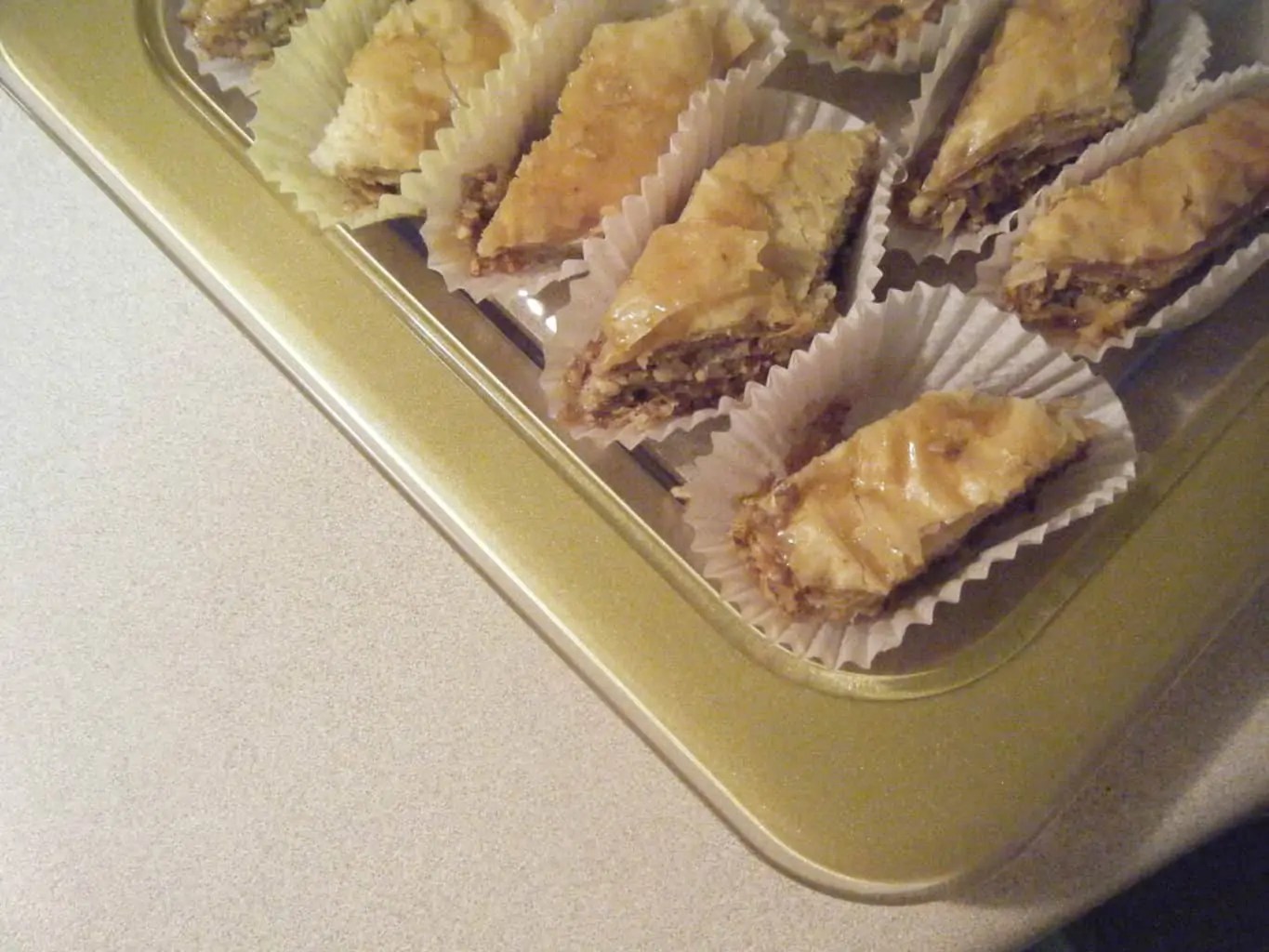
Isn’t it pretty?
Here’s a close up.

See all the layers?
This is wonderful served as a dessert, or for a mid afternoon snack.
Or you can take it to a party and really impress your friends!
And when they ask you, “How do you make Baklava,” you will have an answer for them! 🙂
For best results, store your Baklava uncovered. That way it stays crispy.
Enjoy!


print pin
Baklava
Sweet, gooey, and crispy. The perfect dessert!
Course Dessert
Cuisine Greek
Prep Time 10 minutes minutes
Cook Time 40 minutes minutes
Total Time 1 hour hour 10 minutes minutes
Servings 32 pieces
Calories 222kcal
Author Cery
Ingredients
Baklava
- 1 lb raw, unsalted nuts
- 1 tsp ground cinnamon
- 1/2 tsp ground nutmeg
- 1/2 tsp ground cloves
- 1/2 tsp ground mace
- 1/2 tsp ground cardamom
- 1/2 tsp ground allspice
- 1 pkg phyllo dough
- 1 cup butter melted
Syrup
- 1 cup brown sugar packed
- 1 cup water
- 1/2 cup honey
- 1 tsp homemade vanilla extract
- 1 tsp lemon juice
- 2 cinnamon sticks
- 6 whole cloves
- peel from 1 orange washed, cut in strips, and pith removed
Instructions
Baklava
Preheat oven to 350 degrees.
Butter a 9x13 inch baking dish.
Chop the nuts very fine. You can do this by hand or in a food processor.
After the nuts are fine, mix the ground spices into them.
Ok, now comes the tricky bit. Unroll the phyllo and place it on a cookie sheet (or your counter top if it's clean enough). Mine measured 9x14 so I had to cut an inch off of one end so it would fit my baking dish. Now, cover the phyllo with plastic wrap and then with a damp cloth.
Place 4 to 6 sheets of phyllo in the bottom of your baking dish. Brush generously with the melted butter.
Sprinkle 5 to 6 tablespoons of the nut mixture evenly over the phyllo.
Add 2 more sheets of phyllo dough and brush with butter.
Continue to layer the nuts and phyllo sheets, brushing the sheets with butter as you go, until you have used all of the nut mixture.
For the top layer of phyllo, use 6 to 8 sheets, buttering each one.
Now, using a very sharp knife, cut the Baklava all the way through, into 4 long rows. Then cut diagonally to make diamond shapes.
Place in the preheated oven ad bake for 40-50 minutes, until golden brown.
Syrup
Combine the brown sugar and the water in a small saucepan and bring to a boil.
Add the honey, cinnamon sticks, cloves and orange peel and return to a boil.
Reduce heat and simmer for 20 minutes.
Remove and discard the cloves and cinnamon sticks. The orange peel is now "candied" orange peel and can be used in other recipes.
Add the lemon juice and the vanilla and mix well.
Remove the syrup from the heat and allow to cool slightly.
After removing the Baklava from the oven, immediately spoon the syrup over the top.
Allow the Baklava to cool completely before serving.
Nutrition
Calories: 222kcal | Carbohydrates: 23g | Protein: 4g | Fat: 14g | Saturated Fat: 5g | Trans Fat: 1g | Cholesterol: 15mg | Sodium: 124mg | Potassium: 113mg | Fiber: 2g | Sugar: 11g | Vitamin A: 181IU | Vitamin C: 1mg | Calcium: 24mg | Iron: 1mg
 )
)